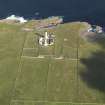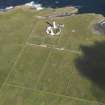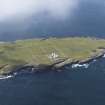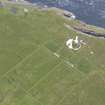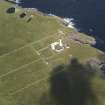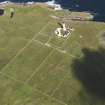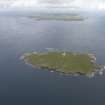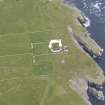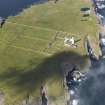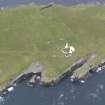Muckle Skerry, Old Lighthouse
Lighthouse (18th Century)
Site Name Muckle Skerry, Old Lighthouse
Classification Lighthouse (18th Century)
Alternative Name(s) Pentland Skerries I
Canmore ID 280324
Site Number ND47NE 11.03
NGR ND 4649 7841
NGR Description ND c. 4649 7841
Datum OSGB36 - NGR
Permalink http://canmore.org.uk/site/280324
- Council Orkney Islands
- Parish South Ronaldsay
- Former Region Orkney Islands Area
- Former District Orkney
- Former County Orkney
ND47NE 11.03 c. 4649 7841
Name: Pentland Skerries I (1794)
Location: N58 41 W2 55 Pentland Firth, 5 miles NE of Duncansby Head
Designed: Thomas Smith
Built: Robert Stevenson
Light first exhibited: 1 October 1794
Description: two circular stone towers, 60ft [18.3m] apart
Height of light above MHW: 171ft (52m); 141ft (43m)
Height of tower: 118ft (36m); 88ft (27m)
Light source and characteristics: fixed white. Oil lamps: 29,000 cp: 18 and 19nm nominal range
Fog warning apparatus: Nil
Manning: watched (boat from St Margaret's Hope, Orkney)
C Nicholson 1995.
Publication Account (2007)
Pentland Skerries Lighthouses
(Institute Civil Engineers Historic Engineering Works no. HEW 1985)
The lighthouses of Orkney represent an important civil engineering contribution to the island and maritime safety. The most historic is the 70 ft tall North Ronaldsay Lighthouse built by the Northern Lighthouse Board in 1789, using local stone and workmen from Leith, only three years after the Board was founded. This lighthouse was closely followed by Pentland Skerries in 1794 to the south at the eastern entrance to the hazardous Pentland Firth. The engineer for both lighthouses was Thomas Smith, who developed, made and installed arrays of facetted mirror-glass parabolic reflector oil lamps.
At Pentland Skerries, Smith directed the erection of two circular masonry towers, 60 ft and 80 ft high, and installed 66 reflector lamps in total. The towers were sited 60 ft apart as a distinction to mariners. In the 1820s they were rebuilt under Robert Stevenson’s direction in local stone 100 ft apart, the taller being 118 ft high. In 1848 lenses were introduced. The lower light was discontinued in 1895 on the introduction of group flashing lights. The light was converted to electrical operation in 1939.
R Paxton and J Shipway, 2007.
Reproduced from 'Civil Engineering heritage: Scotland - Highlands and Islands' with kind permission from Thomas Telford Publishers.




















